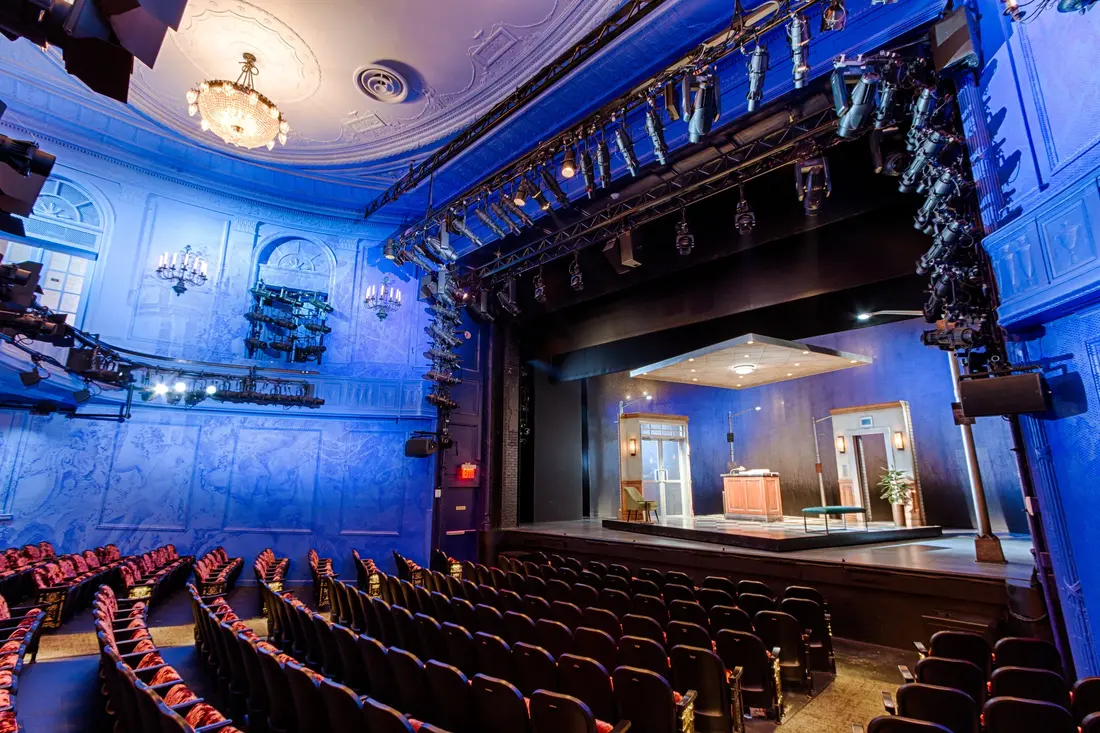The Hayes Theater Information

The Hayes Theater in NYC, initially known as the Little Theatre, held its grand opening in March 1912. It was originally built for theater director, producer, and playwright Winthrop Ames and designed by celebrated architects F. Burrall Hoffman, Jr. and Harry Creighton Ingalls. It featured ornamental plasterwork and Adam-style designs that quickly made it one of the many must-see sites in Midtown Manhattan’s Theater District.
At first, the Little Theatre was a single-story theater that could only seat 299 spectators. The Pigeon was the first play ever held on its stage. Others, like Snow White and the Seven Dwarfs (1912), The Philanderer (1913), Please Get Married (1919), Beyond the Horizon (1920), and A Midsummer Night’s Dream (1920) also enjoyed runs during the theater’s first decade.
By the 1920s, the Little Theatre was already starting to burst at the seams. This led to legendary theater architect Herbert J. Krapp modifying it to accommodate more visitors. He added a balcony to the theater, expanding the venue’s capacity to 597 spectators.
The Little Theatre almost met its demise a short time later. After Ames leased it to theatrical producers like Oliver Morosco and John Golden throughout the 1920s, the New York Times Company purchased it in the early 1930s and planned to demolish it. The burgeoning media conglomerate eventually decided against it and continued to allow plays to take place; however, the company transformed it into a conference hall in the 1940s and a broadcasting studio in the 1950s and 1960s.
At the start of the 1970s, it appeared as though the Little Theatre’s time as a Broadway playhouse was destined to become a distant memory. But it once again started hosting plays in the late 1970s when Broadway producers Martin Markinson and Donald Tick bought it. They renamed the theater after the ”First Lady of American Theatre,” Helen Hayes, in 1983 and brought it back to its roots over the next three decades as plays like By Jeeves (2001), Xanadu (2007), and Rock of Ages (2011) took to its stage.
In 2015, the non-profit theater company Second Stage Theater purchased the Helen Hayes Theater and shortened its name to the Hayes Theater. It underwent a historic renovation and reopened in 2018. Since then, it has hosted Straight White Men (2018), Take Me Out (2022), and, most recently, Mother Play, Job, and Cult of Love in 2024.
About the Venue
The Hayes Theater in NYC, or the Little Theatre as it was initially called, is located at 240 West 44th Street in Midtown Manhattan’s Theater District. Although it had a capacity of under 300 during its early days, that number increased to nearly 600 when a balcony was added in 1920. Still, this slight expansion didn’t stop it from turning into one of the most intimate Broadway theaters in the Big Apple.
Many Broadway enthusiasts fall in love with the Hayes Theater before even setting foot inside. Its beautiful red brick facade with limestone trim helped its exterior earn New York City Landmark status in 1987. The interior’s lobby and auditorium also earned New York City Landmark status at the same time.
When visitors step through the large brick arch entryway leading into the Hayes Theater, they’re greeted by its box office and lobby, which feature a whole host of stunning design pieces. This area bursts with character, from Ionic columns to a showstopping chandelier hanging from an Adam-style medallion.
The auditorium in the Hayes Theater in NYC is every bit as quaint as you might imagine. Though it’s larger than when F. Burrall Hoffman, Jr. and Harry Creighton Ingalls first constructed it for Winthrop Ames in the 1910s, it still has a small footprint featuring little more than an orchestra level, a balcony, and a stage. However, it has many decorative touches, including the ornate plasterwork on the ceiling and a breathtaking proscenium, that help bring the space to life.
Venue History
Throughout the 1800s, most Broadway theaters built in New York City were situated in the Madison Square and Union Square areas. However, at the beginning of the 1900s, the theater district started to shift toward the Times Square area, as over 40 theaters were built during the first two decades of the new century. Winthrop Ames, who had helped develop the New Theatre in New York City and the Castle Square Theatre in Boston, chose to join the so-called Little Theatre Movement and built the Little Theatre, later known as the Hayes Theater, in the heart of NYC.
Initially, critics panned many of the ideas Ames shared regarding his plans for the Little Theatre. They argued that it was too far from Times Square and that its size would make it elitist. Since it was so small, Ames noted that every seat in the theater would offer a great view, so he planned to charge the same price — $2.50 or just over $75 today — for each ticket to a show.
Ames proved his critics wrong, but he also struggled to turn consistent profits with the Little Theatre since there were only so many tickets he could sell to Broadway shows. This would eventually lead to Ames hiring architect Herbert J. Krapp to make the theater larger by building a balcony. He originally planned to increase the theater’s capacity to about 1,000, but he could only add around 300 more seats, keeping the capacity just below 600.
Ames retired from producing Broadway shows in the late 1920s and started leasing the Little Theatre out to other Broadway producers, including John Golden, L. Lawrence Weber, and F. Ray Comstock. By the early 1930s, the New York Times Company bought it and was on the verge of tearing it down and ending the Little Theatre’s run for good.
Interestingly enough, the Great Depression may have saved it. The New York Times Company chose to keep it open for at least a year after buying it to generate income by leasing it to the Little Theatre Operating Company. Several other organizations also leased it before it was turned into the New York Times Hall in the early 1940s and used as a conference center. It was then converted into a broadcasting studio for ABC and other companies in the 1950s and 1960s.
But the Little Theatre didn’t stay out of the Broadway business for long. It changed hands numerous times throughout the 1960s and 1970s before Martin Markinson and Donald Tick purchased it and relaunched it as the Helen Hayes Theater. It operated as the Helen Hayes Theater for about 30 years before Second Stage Theater purchased it for about $28 million in 2015.
Second Stage would go on to spend over $20 million renovating the Helen Hayes Theater. Architect David Rockwell and his Rockwell Group handled the renovations and helped turn the Hayes Theater in NYC into what it is today. The venue reopened in 2018 after having its name shortened to the Hayes Theater, much to the excitement of new and veteran theater-goers alike.
More The Hayes Theater NYC information:
Ticket Policies:
Policies and authenticity guarantee regarding tickets from our recommended ticket marketplace.
Seating Chart:
View the standard The Hayes Theater NYC seating map and read about different seating options.
Parking Information:
Information about the The Hayes Theater parking options.
